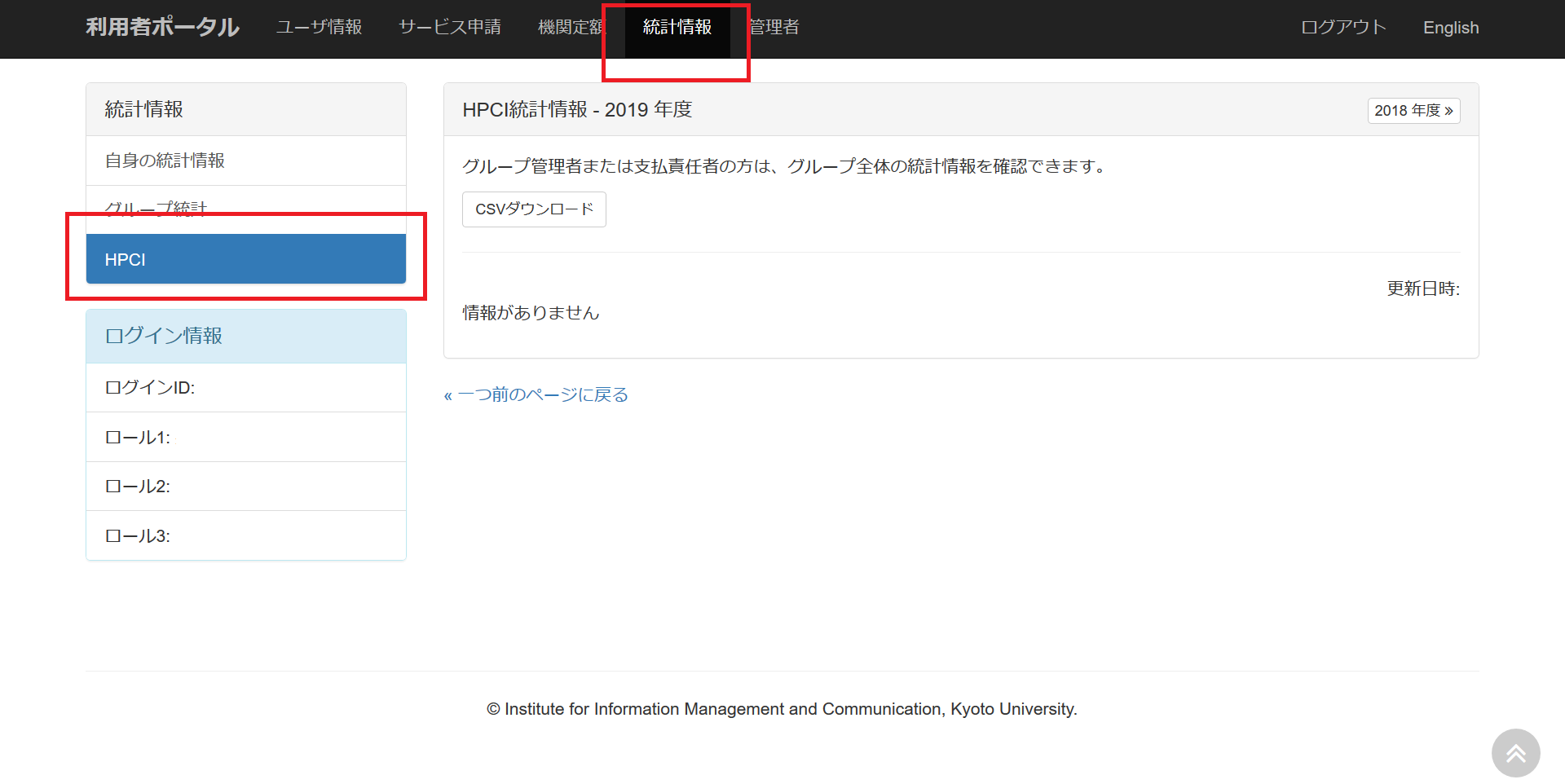HPCI User's Guide
This page explains how to use Academic Center for Computing and Media Studies, Kyoto University (ACCMS) for HPCI.
For those who have completed registration for use of our supercomputer, we will send a Notification of the Registration Completion by email. Once you receive the Notification of the Registration Completion, please follow the Procedure to Start the Service.
The user ID notified in the “Notification of the Registration Completion” is used for the purposes shown in the table below. It may fall into both categories. You can confirm the primary center and computing resources from HPCI online application system .
| Category | Usage of user ID |
|---|---|
| Those who designate Kyoto University as the primary center | Use this user ID as a HPCI account when WEB authentication is required, such as issuing a certificate. |
Please refer to the Manual provided by HPCI on how to issue client certificates and log in. The host names for using Kyoto University computing resources are as follows.
| System | Host |
|---|---|
| System A | camphor.kudpc.kyoto-u.ac.jp |
HPCI uses client certificates to log in to resource providers via SSH (OAuth-SSH) with OAuth authentication.
If you have access to Kyoto University's computing resources, you can log in by referring to the page here, and you will be able to log in to other system configuration institutions via Kyoto University's computing resources without having to set up an environment for HPCI.
##Start jwt-agent (please replace hpci00XXXX with your own HPCI-ID)
$ jwt-agent -s https://elpis.hpci.nii.ac.jp/ -l hpci00XXXX
## Log in to other resource providers
$ hpcissh host01.example.jp Please refer to Access for how to use the system. The system available for HPCI is System A.
To use HPCI's computing resources, the following queue name must be specified when submitting jobs in batch. Please refer to Batch Processing on how to use the batch system, .
The HPCI proposal ID included in the queue name is the ID of the proposal that was firstly approved.
| Classification | System | Type | Queue Name | Number of Nodes (FY2025) | Notes |
|---|---|---|---|---|---|
| HPCI | A | All year use | hpa | 168 Nodes | Shared by HPCI users. Please do not occupy for a long period of time, as it will be shared and used for multiple proposals. |
| HPCI-JHPCN | A | All year use | jha | 14 Nodes | Shared by HPCI-JHPCN users. Please do not occupy for a long period of time, as it will be shared and used for multiple proposals. |
| HPCI-JHPCN | A | Intensive use | jhXXXXXXa | - | Please replace hpci00XXXX with your own HPCI-ID. The period of use will be notified individually to the proposal representatives. |
Kyoto University uses the same login ID (user number) even when multiple proposals are adopted by HPCI. You can check the used node time in Confirmation of usage status. However, Kyoto University is registered for multiple proposals and the operation is to divide the node time by the number of issues and accumulate it to each proposal when the GID is the default. When you accumulate a node time to a specific proposal, please change the GID to the desired group using the newgrp command and then submit the job.
When you use the newgrp command and have a trouble with LD_LIBRARY_PATH not being inherited, please use the command reload_modules.
The storage paths that can be used for HPCI proposals are /LARGE0/initially adopted ID and /LARGE1/initial proposal ID.
(e.g.) If your initial proposal ID is “hp1999999”, you can use the directories under /LARGE0/hp1999999 and /LARGE1/hp1999999.
Available capacities per proposals are as follows
| Proposal | Available Capacity |
|---|---|
| HPCI proposal uses System A | Listed in the Large Disk column of the Resource Offer Notice (Allocate half to /LARGE0 and /LARGE1) |
| HPCI-JHPCN proposal uses System A | Listed in the Large Disk column of the Resource Offer Notice (Allocate half to /LARGE0 and /LARGE1) |
/LARGE1 is the backup destination for /LARGE0 by default. /LARGE1 is available by removing the backup. To change your backup settings, please contact us via the Inquiry Form.
In addition to this, home directories are available up to 100 GB. For more details on how to use storage, please refer to Using the File System.
The mount points for users of the proposals for which HPCI shared storage is available are as follows. Please refer to the HPCI Shared Storage User Manual for details on how to use.
| Mount Point |
|---|
| /gfarm/Proposal ID/User ID |
You can confirm the usage status by logging in to the User Portal, clicking on HPCI in the left menu from the Statistics section of the upper menu.

If you divide the value of core elapsed time (in seconds) by 3600 and set the unit to "hours" and divide by 112 (the number of cores per node in System A), you can calculate the actual utilization against the node time of the available quota. Please note that information on all users who can use the queue is displayed on this page, so it is necessary to compare the total value with the time allocated for the proposals.
HPCI has a management system for users of the HPCI system to share information and documents from each system institutions.